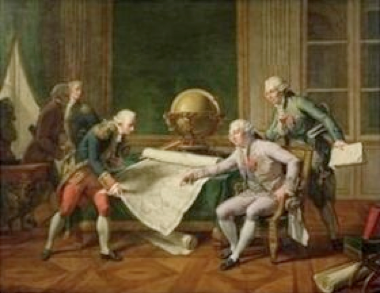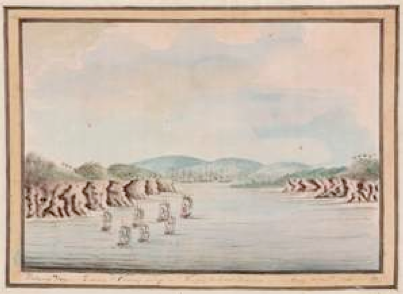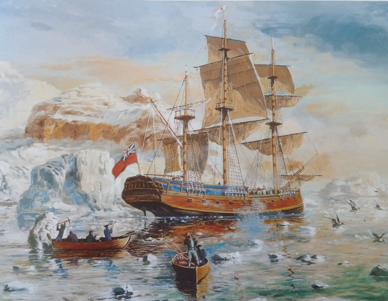
Jan. 1789 BOTANY BAY. “THE RACE THAT NEVER WAS”
ALTHOUGH******what priceless TIMING after all the difficulties and delays experienced by both sides.
ON THE STARTING BLOCKS the ENGLISH.
The English, in 1886. starting planning to re locate their ”jailbirds” in that faraway place called Australia. Captain Arthur Phillip was scheduled to leave England with the First Fleet in 1787.
No doubt the concept, was championed by the eminent Joseph Banks, who as a rich spoiled young Naturalist accompanied Captain James Cook on his first world voyage; when Cook discovered and charted the east of Australia, and claimed the land as English.
ON THE STARTING BLOCKS, the FRENCH at KAMCHATKA PENINSULA in 1887.
The French in 1887 under La Perouse, were nearing the end of an ambitious scientific voyage expedition to explore the Pacific Ocean, that was sanctioned and encouraged by the King of France Louis XV1, who was shortly to be guillotined during the French revolution. Napoleon Bonaparte as a 16 year old had applied for a position with the expedition, but was knocked back. Captain Cook’s 3 world discovery voyages had left little in the world to explore, so the French decided to “study” in depth the known world. It is probably fair to say that Charles Pierre Claret de Fleurieu, an influential French Geographer, had a big hand in planning the route to be taken, and helping decide the timetable of communication..
 King Louis XV1, and La Perouse.
King Louis XV1, and La Perouse.
OFFICIAL STARTER Capn. James Cook, with his 3 Voyages.
Starter Helpers: Joseph Banks; Lt. Hicks the American, who first saw Victoria; Lt. Bligh;
Capn. Clerk; Lt. Gore; Cook’s widow, who saw the First Fleet depart for Australia,
WHAT IF ?
If the French ships had made a landfall just 10 kilometres up the Coast from Botany Bay, a few days earlier in 1789, they may have entered Port Jackson before the First Fleet. Would they have planted the French Flag? After all Captain Cook DID NOT enter Port Jackson. Did they have access to Captain Cook’s maps and so made a direct landfall at Botany Bay? After all they only had to sail due south from Kamchatka to reach Australia.
REALITY !
 First Fleet Arrival Botany Bay
First Fleet Arrival Botany Bay
When part of the English First Fleet was harboured in Botany Bay, on Dec 1788, sails were seen off the coast. It was the French expedition led by Jean Francoise de Galaup, Compte de La Perouse, they were driven off the coast by winds and disappeared for several days. In the interim, most of the English First Fleet had moved up to Farm Cove just to the east of the current day Opera House in Port Jackson
English Fleet, whilst not on a war footing, nevertheless, did have fighting men and some cannons, that would have been more than a match for the French.
The French stayed for some time, encamped ashore at Botany Bay. Civilised visit’s from Officers of both sides eventuated. In fact the French rejected taking escaped convicts.
VERY SHORT VERSION OF HOW BOTH SIDES ARRIVED AT AUSTRALIA.
The French.
The French, two ships The Astrolabe and Boussole, Officers and men, were in reality supporting and carrying out only a scientific exploration, and had been travelling for 3 years.
Finally the French got to the Kamchatka Peninsula, inhabited by a very few Russians. Cook had not quite got to this area, in his search for the North West Passage.
 Cook in the Arctic ?
Cook in the Arctic ?
The French had sailed up past China, through the gap between Korea and Japan, past Nagasaki to arrive. Previously, the Portuguese, Spanish and Dutch had explored these waters in the 1600’s. At this time Christianity was a forbidden religion. Howeve,r Bougainville was the first Frenchman to circumnavigate the world and that was only in 1700’s
The French at that time, were not at war with England. Although they had fought on the side of America in its War of Independence against England. In fact Joseph Banks was instrumental in obtaining for the French two of James Cook’s inclining compasses.
Orders were received at the Kamchatka Peninsula, for the expedition to go and observe the founding of the English settlement in Australia. The French Minister of Marine was planning on La Perouse being at Vladivostok on the Peninsula. La Perouse sent a Voyage Report, back to Paris via Barthelemy de Lesseps, who took 12 months by land from Kamchatka. He was an earlier relative of the Suez Canal Engineer Ferdinand de Lesseps. On the way to Botany Bay, 12 men were killed by Samoan natives that would have delayed them.
The English.
With the successful American revolution, against English rule, England had no where to send its enormous quantity of jailed persons. Mostly created by unfair and unjust living conditions that existed in England at the time.
Some bright sparks in the English Government decided to send them to that remote place in the Pacific that had been seen by Captain Cook on Aug 28th 1770; that gave rise to the English First Fleet , under the control of Captain Arthur Phillip. Phillip was aware that the French were in the Pacific Ocean.
The French “adopted” the idea of sending “convicts” to overseas destinations about 1852.
VERY SHORT VERSION OF HOW THE ENGLISH AND FRENCH KNEW ABOUT AUSTRALIA.
Both sides, had over the years, been aware of the Portuguese and Dutch expeditions, down the West Coast of Africa and across to “Indonesia” sometimes landing on the West Coast of Australia. The Dutch in particular explored around Tasmania and to the North. An Englishman William Dampier, called a Pirate, Privateer and Hydrographer, actually landed on the Coast on the West Coast of Western Australia twice. First in 1688 then 1699. He also had a hand in marooning Alexander Selkirk (of Robinson Crusoe fame) on Juan Fernandez isle off the coast of Chile.
Louis Antoine de Bouganville, a contemporary of James Cook, would probably have landed on the north East coast of Australia but was beaten by the great waves, maybe off the Great Barrier Reef. He was actually the first Frenchman to navigate the World.
Click Here to Download a PDF of this Short Story.